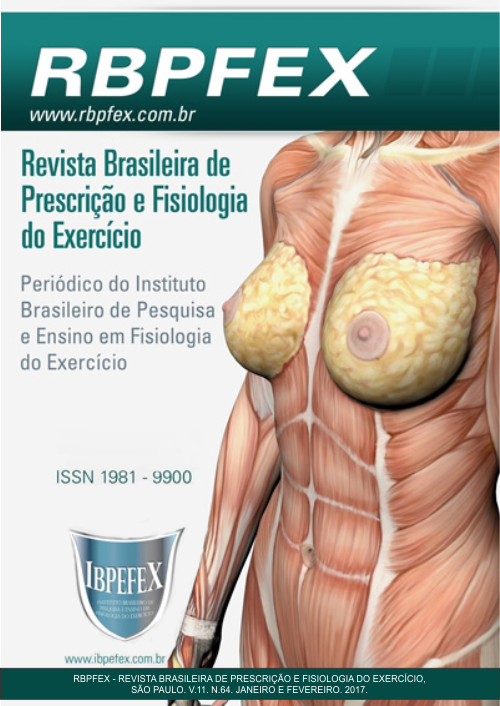The effect of alternation in the exercises of large and small groupings in lower limbs on lactacidemia and cardiovascular parameters
Abstract
The aim of this study was to investigate the influence of alternating the exercises execution order for legs: Squat Free (AGL) and extensor chair (EC) on the lactacidemia, perception scale of OMNI effort and cardiovascular parameters. 10 volunteers 27.3 ± 1.7 anos; 177.3 ± 2.4cm; 87.5 ± 4.1kg were two sequences of 3 sets of 10 repetitions at 70% 1RM squat free (SF) and leg extension (LE) alternating exercises. The first sequence SF and EC and the second sequence LE and SF. They were measured at rest and after each series: lactacidemia, perceived exertion by OMNI, heart rate, systolic blood pressure, diastolic blood pressure and double product. All parameters studied showed significant increases in the second sequence when compared to the first sequence. We therefore conclude that performing a sequence resistance exercise starting with recruitment of small anterior muscle groups to large groups induces a significant stress on the metabolic system (lactacidemia), perceived exertion (scale of perceived OMNI effort) and cardiovascular system ( HR, SBP, DBP and DP). Therefore, the rules of the American College of Sports Medicine suggests training large previous groups small is adequate, we suggest that the alternation would have carried a stress overload and increased fatigue, it may be the objective of some resistance training programs in order muscle hypertrophy.
References
-ACSM. Progression modelsin resistance training for healthy adults. Med Sci Sports Exerc. Vol. 41. p. 687-708. 2009.
-Balsamo, S.; Tibana, R. A.; Nascimento, D. D. A. C.; Franz, C. B.; Lyons, S.; Faigenbaum, A.; Prestes, J. Exercise order influences of repetitions and lactate levels but not perceived exertions during resistance exercise in adolescents. Res Sports Med. Vol. 21. Núm. 4. p. 293-304. 2013.
-Bellezza, P. A.; Hall, E. E.; Miller, P. C.; Bixby, W. R. The influence of exercise order on blood lactate, perceptual, and affective responses. J Strength Cond Res. Vol. 23. Núm. 1. p. 203-208. 2009.
-D’Assunção, W.; Daltro, M.; Simão, R.; Polito, M.; Monteiro, W. Respostas cardiovasculares agudas no treinamento de força conduzido em exercícios para grandes e pequenos grupamentos musculares. Rev Bras Med Esporte. Vol. 13. Núm. 2. 2007.
-Delavier, F. Guia dos movimentos de musculação: abordagem anatômica. 3ª edição. São Paulo. Manole. 2002.
-Kraemer W. J.; Ratamess, N. A. Fundamentals of resistance training: progression and exercise prescription. Medicine and Science Sports and Exercise. Vol. 36. Núm. 4. p. 674-688. 2004.
-Lagally, K. M.; Robertson, R. J. Construct validity of the OMNI Resistance Exercise Scale. J Strength Cond. Res. Vol. 202. Núm. 2. p. 252-256. 2006.
-Uchida, M. C.; Bacurau, R. F. P.; Navarro, F.; Pontes Jr, F. L.; Charro, M. A. Manual de musculação: uma abordagem teórico-prática ao treinamento de força. Phorte. 5ª edição. 2008. p3.
-Simão, R.; Farinatti, P.; Polito, M. D.; Viveiros, L.; Fleck, S. J. Influence of exercise order on the number of repetitions performed and perceived exertion during resistance exercise in women. J Strength Cond Res. Vol. 21. Núm. 1. p. 23-28. 2007.
-Tan, B. Manipulating Resistance Training Program Variables to Optimize Maximum Strength in Men: A Review. Journal of Strength and Conditioning Research. Vol. 13. Núm. 3. p. 289-304. 1999.
Authors who publish in this journal agree to the following terms:
- Authors retain the copyright and grant the journal the right of first publication, with work simultaneously licensed under the Creative Commons Attribution License BY-NC which allows the sharing of the work with acknowledgment of the authorship of the work and initial publication in this journal.
- Authors are authorized to enter into additional contracts separately for non-exclusive distribution of the version of the work published in this journal (eg, publishing in institutional repository or book chapter), with acknowledgment of authorship and initial publication in this journal.
- Authors are allowed and encouraged to post and distribute their work online (eg, in institutional repositories or on their personal page) at any point before or during the editorial process, as this can bring about productive change as well as increase impact and impact. citation of published work (See The Effect of Free Access).






